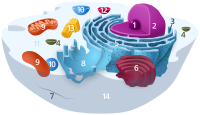
Photo from wikipedia
The dermal compartment of skin is primarily composed of collagen‐rich extracellular matrix (ECM), which is produced by dermal fibroblasts. In Young skin, fibroblasts attach to the ECM through integrins. During… Click to show full abstract
The dermal compartment of skin is primarily composed of collagen‐rich extracellular matrix (ECM), which is produced by dermal fibroblasts. In Young skin, fibroblasts attach to the ECM through integrins. During ageing, fragmentation of the dermal ECM limits fibroblast attachment. This reduced attachment is associated with decreased collagen production, a major cause of skin thinning and fragility, in the elderly. Fibroblast attachment promotes assembly of the cellular actin cytoskeleton, which generates mechanical forces needed for structural support. The mechanism(s) linking reduced assembly of the actin cytoskeleton to decreased collagen production remains unclear. Here, we report that disassembly of the actin cytoskeleton results in impairment of TGF‐β pathway, which controls collagen production, in dermal fibroblasts. Cytoskeleton disassembly rapidly down‐regulates TGF‐β type II receptor (TβRII) levels. This down‐regulation leads to reduced activation of downstream effectors Smad2/Smad3 and CCN2, resulting in decreased collagen production. These responses are fully reversible; restoration of actin cytoskeleton assembly up‐regulates TβRII, Smad2/Smad3, CCN2 and collagen expression. Finally, actin cytoskeleton‐dependent reduction of TβRII is mediated by induction of microRNA 21, a potent inhibitor of TβRII protein expression. Our findings reveal a novel mechanism that links actin cytoskeleton assembly and collagen expression in dermal fibroblasts. This mechanism likely contributes to loss of TβRII and collagen production, which are observed in aged human skin.
Journal Title: Journal of Cellular and Molecular Medicine
Year Published: 2018
Link to full text (if available)
Share on Social Media: Sign Up to like & get
recommendations!